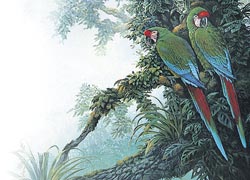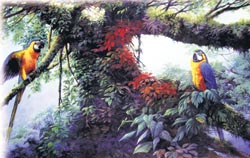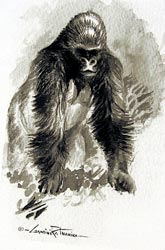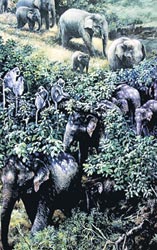
Canvas coloured by the call of natureThe day he was born a Scops owl flew into his room and perched on his crib, his parents told him. That was his first link with nature.“Five years later, when I found myself in a boarding school after my parents’ divorce, I started searching for ways to overcome my loneliness. Looking into a raindrop on a leaf, I saw the colours of the rainbow, all of nature around me, and my reflection so perfectly. As it rolled off the leaf and was absorbed by the earth to nourish a tree, I realised what a complex system nature was,” says Gamini Ratnavira, renowned nature artist, passionate conservationist, devoted husband, loving father and national treasure.
The first thing you realise when talking to this man is, just how fascinating he is. His memorable childhood, his countless adventures and travels…in short, his life’s experiences can be termed as nothing short of intriguing. What else can you say of a man who’s had a baby elephant living in his bedroom? It was apparently orphaned and rescued from the wilds by his aunt but, had stayed on with Gamini as it had grown quite fond of him. “It was easier living with an elephant, than most humans I’ve met in my life,” he says laughing. It was not just elephants. Young Gamini’s mini menagerie comprised a series of pet pythons and snakes, squirrels in his pocket and baby birds in his suitcase when at boarding school. He recalls buying a pigeon off his childhood friend Aloy Diaz, for ten rupees. Gamini’s photographic memory seems to be his secret weapon when recreating what he’s seen, on canvas. Drawing, from the time he was only five (even though they didn’t resemble anything in particular, at the time), was his way of bringing back and capturing memories of what he’d seen. An old boy of De Mazenod College - Kandana, he hadn’t even been allowed into art classes since the fifth grade after falling out with the art master, he says with a smile.
“It was actually quite embarrassing when I first started painting professionally at 19, because I had no clue about the various colours and shades etc. All I was interested in was how to bring the bird or whatever it was to life on my canvas,” he says. Most birds or any creature for that matter, have specific shapes of feathers or markings etc., so it’s vital that a nature artist thoroughly studies his subjects prior to making any attempt at depicting them exactly as they are in the wild, he explained. “I now use all types of mediums to depict wildlife; oils, acrylics, water colours and even bronzes and sculptures.” Interviewing Gamini is an experience itself, as knowingly or unknowingly you walk out being much more aware of your environment. His power to mesmerise his audience with his passion for nature, is astounding. “Most of my work is not just about the art but, more so to highlight why animals, birds or even fauna are vital in the conservation of nature,” he said. For instance if one were to observe a herd of elephants say at the Yala National Park (as depicted in his work "Friends in High Places"), you’d see how there would always be a group of monkeys and Bee-eaters travelling along with them overhead. This is for the simple and quite obvious reason that when the monkeys eat leaves, they always drop a few, thereby, the baby elephants that can’t reach the high branches can get some food. In turn, the Bee-eaters feed on the insects that are attracted to the elephant droppings (dung) and horseflies which are incidentally quite harmful to the elephants. So, it shows the symbiotic relationship all creatures share with one another, irrespective of species or size.
Never having taken an art lesson in his life, he learnt at a young age, that nature was in fact his best teacher. His life’s work is a direct result of his extensive exposure, having travelled to over 40 countries researching endangered fauna and flora. Some of his conservation related work in Sri Lanka includes raising funds for conservation by illustrating 38 stamps featuring, birds, butterflies, orchids, elephants and mangrove swamps, in aid of conservation in Sri Lanka, raising US$10,000 for tsunami victims via the ‘Hidden Forest Art Gallery & Nature Center’ (his personal gallery) in the USA and continuously supporting the Prithipura Infant Home in Sri Lanka that his father, Sardha, first bought all the beds for. At present, Gamini has two conservation fundraisers in the pipeline. One, an art exhibition in collaboration with Prof. Sarath Kotagama to raise funds for his conservation organisation - Field Ornithology Group of Sri Lanka (FOGSL) and two to illustrate a field guide on the birds of Sri Lanka, the proceeds of which will go towards various conservation efforts in the country. Before he left for the States 20 years ago, where he now lives, Gamini was appointed by the then President J.R. Jayewardene to act as a consultant to the Department of Wildlife Conservation and was commissioned by the President to draw a painting for the International Airport. This 8’ x 16’ canvas on ‘Sri Lankan Parakeets’, still hangs proudly on one of the airport walls. President Jayawardene, was a big fan of Gamini’s paintings and even replaced many of the paintings in his home and office, with some of Gamini’s works.
Gamini later had the opportunity to work with the likes of Prince Philip and Sir Peter Scott, both former presidents of the World Wildlife Fund (WWF). Proof of his prowess as an artist requires little spelling out. During a ‘one man show’ in Colombo, he sold 150 paintings within the first hour. He was also commissioned by the then Habarana Lodge (now Cinnamon Lodge) to draw an original painting for each room. Thus 140 of Gamini’s original paintings still adorn each bedroom wall. Currently slotted in as the number one rainforest artist in the world, by the ‘Rainforest Museum Tour’, Gamini was honoured by the Sri Lankan community in Los Angeles (LA) by being given an ‘Award of Excellence’ - for his contribution to the art world. “This was quite a significant event for me, because most of the Sri Lankan community in LA weren’t too fond of me initially, because I married an American and I was not a very sociable person,” he said. “But that’s just how I am. It’s not that I go out of my way to avoid them. I spend most of my time with the canvas, my family or nature,” he said quite matter-of-factly. Churning out paintings at a rate of 100-150 a year, this comes as little surprise! “Art has been my sole means of making a living from the time I was just 19. From the time I got married, it’s just been a case of paint, sell and feed the kids…,” he said with a laugh. “My wife, a poet, teacher and environmentalist like me, takes care of my entire business. All I do is paint. From my write-ups to maintaining my website, to correspondence, she handles it all. I owe most of my success to her tireless efforts,” says Gamini. “My whole family paints now - my wife and three kids too,” he adds proudly. Having viewed more than 5000 species of birds around the world (about half the entire world population) and more than ¾ of the cat species of the world, he is involved in conservation efforts across the globe. His upcoming limited edition portfolio and monograph is of ‘All the Wild Cats of the World’, by Jim Sanderson who has been working on it for the past eight years. He’s done similar portfolios on macaws, parrots, trogons, quetzals etc., and has plans to do one on the humming birds of the world as well. “I like to take whoever views my paintings to the location; painting is like a window to nature. I feel as though I’m seated on a tree, painting what’s all around me,” he explains. “My close relationship and understanding with nature is the only way that I am able to recreate in my painting the beauty of our surroundings. In my rainforest paintings, I share that beauty with you,” says Gamini from the heart. For more information on Gamini, visit http://www.gaminiratnavira.com |
|| Front
Page | News | Editorial | Columns | Sports | Plus | Financial
Times | International | Mirror | TV
Times | Funday
Times || |
| |
Copyright
2007 Wijeya
Newspapers Ltd.Colombo. Sri Lanka. |




